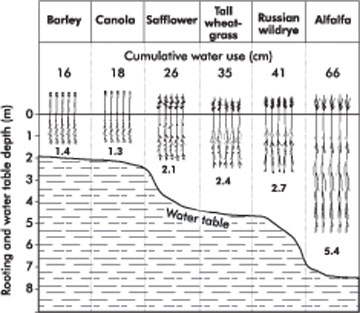| | How these controls work | Growing alfalfa in recharge areas
Saline seeps result when salt-laden groundwater rises to within a few metres of the soil surface. Once the water is in the soil’s capillary zone, evaporation as well as cohesive and adhesive forces act like the wick in a kerosene lamp to draw saline water into the root zone or topsoil. Water then evaporates and the salts remain, gradually accumulating over time.
Contact and slope-change saline seeps types are influenced by groundwater recharge from areas located upslope of the seep (see Alberta Agriculture and Food’s factsheet Dryland Saline Seeps: Types and Causes, Agdex 518-12). These recharge areas can influence seep groundwater if precipitation in excess of crop use either runs off or percolates below the root zone, accumulates and then moves along impermeable soil layers toward the saline seep.
Ensuring that available precipitation is used for productive crop growth rather than contributing to runoff or groundwater buildup is one of the most practical and cost effective control strategies for contact or slope-change salinity. This approach involves rotations with deep-rooted perennials and annual crops that are more water-use-intensive than traditional cropping practices.
Using direct seeding methods for annual crop production is also beneficial since the method improves soil water infiltration rates, reducing runoff potential from saline seep recharge areas.
How These Controls Work
To be effective in controlling contact or slope-change salinity, vegetation grown in the recharge areas must use all the available precipitation for productive crop growth and must minimize the potential for water runoff. Reducing water contributions to the seep area from runoff and groundwater flow helps to do three things:
- lower the seep area groundwater
- stop the capillary rise of salts
- allow precipitation to leach salts further into the soil profile
Gradually, the saline seep can support the growth of salt-tolerant forages (see the factsheet Perennial Forages for Saline Seeps, Agdex 518-19) and may, in time, be reclaimed for selected annual crops as salt levels in the root zone diminish (see the factsheet Salt Tolerance of Plants, Agdex 518-17).
Deep-rooted perennial forages are preferred for dominant recharge areas, which are defined as those portions of the entire recharge that contribute most to high water tables. Most perennials can respond to fall and early spring precipitation while most annual crops cannot.
Deep-rooted perennial forages also use more water per unit depth of soil and from a greater depth (Figure 1) than annual crops. Annual cropping is suitable for the remainder of the recharge area and can be rotated with perennials in the dominant recharge.

Figure 1. Cumulative water use and rooting depth of crops over a four-year period
Vegetative controls of groundwater recharge are more effective for contact and slope-change salinity but not for coulee bottom, outcrop or artesian seeps because the recharge is usually too large or too poorly defined for biological controls to be effective (see Dryland Saline Seeps: Types and Causes, Agdex 518-12).
Growing Alfalfa in Recharge Areas
Alfalfa is preferred for planting in dominant recharge areas because of its deep-rooting capability, high water-use requirement, extended growing season and commercial value.
Tap-rooted alfalfa varieties generally have deeper rooting capabilities than creeping-rooted varieties. Tap-rooted alfalfa has the potential to consume up to 650 mm (26 inches) of soil water (precipitation or groundwater) during a single growing season. The varieties can root up to 6 m deep over a 5 to 6-year period, depending on the depth of soil, bedrock and water table.
Alfalfa should be used in areas that have ample precipitation and deep soils with a high water-holding capacity. Areas without these factors are better suited to shallower-rooted crops.
Site selection
Seeding alfalfa into the dominant recharge area of a contact or a slope-change saline seep is often the quickest and most effective way to control the seep. Most of the region upslope of a contact or slope-change seep may be a potential recharge area. Those portions of the upslope area that are dominant recharge areas are often characterized by depressions, watercourses, borrow pits and shelterbelts where water and snow accumulate.
Areas with coarse-textured soils or shallow bedrock with a low potential for additional moisture storage and areas with shallow water tables may also be dominant recharge areas. Dominant recharge areas are, on average, about three to five times larger than their saline seep. These areas are often close to the seep, typically within 1 km for slope-change and contact saline seeps.
Variety selection and establishment
Tap-rooted varieties of alfalfa are generally recommended for recharge control. However, if stand establishment is a concern, then creeping-rooted varieties can be mixed with tap-rooted varieties to help fill in the stand..
Establishing good alfalfa stands
The establishment of a productive alfalfa stand can be challenging in dryland situations. Some of the issues to consider include planting rates, proper inoculation, planting equipment, companion crops and fertilization. The factsheet Perennial Forage Establishment in Alberta, Agdex 120/22-3, provides information on these and other issues related to successful alfalfa establishment.
Stand duration
Alfalfa stands are most productive in the first three to four years after establishment, but they may continue to have reclamation benefits for up to six years, depending on the situation. Water use by alfalfa in the dominant recharge combined with saline-tolerant forage growth in the seep helps lower the water table, encouraging deeper leaching of soluble salts. Dominant recharge areas can often be converted back to annual crops without losing ground to salinity, but care must be taken to re-establish alfalfa before the seep area water table begins to rise following years with excessive rainfall or runoff.
More information
For more information on salinity control, contact the Alberta Ag-Info Centre at 310-FARM (3276) or refer to the factsheet Dryland Saline Seeps, Types and Causes, Agdex 518-12.
Prepared by
Alberta Agriculture and Forestry
Source: Agdex 518-18. June 2007. |
|